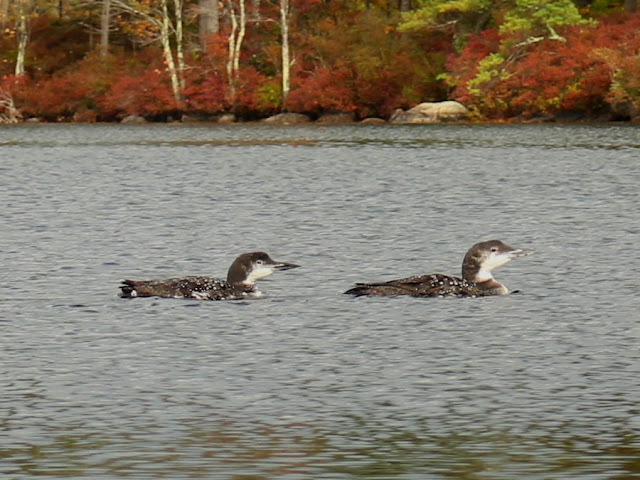Earlier this summer (see August 16, 2020) I spent a few minutes watching a pair of young fawns cavorting around the edge of Lake Wicwas, chasing each other up and down the shoreline like a couple of energetic kids. Well, they're still around, and I've bumped into them several times over the past couple of weeks. They are always together and seem to have separated from their mother, though I'm sure mom is nearby. One morning this week I caught them right at the water's edge having breakfast.
 |
| Breakfast time on the lake. |
One sibling seems a bit larger than the other, and that one was ready to play, dashing off into the woods, hoping to be chased.
 |
| "Tag, you're it!" |
But the smaller fawn was more intent on filling up its belly, knowing this is the time to eat as much as possible to put on the thick layer of fat needed to get through the approaching winter. Besides, it seemed he wanted to visit with the wood ducks that were approaching.
 |
| "Good morning Wood Ducks." |
Having not drawn a playmate, big brother or sister came back shortly to check in.
 |
| It's no fun to play alone. |
The two munched for a while on the tender shoreline flora before slowly sauntering back up into the trees to enjoy the day. But the wood ducks came back about an hour when the lighting was better and I remembered just why these are my favorite ducks to see on the lake.
 |
| Mr. and Mrs. Wood Duck |
The hen (female) has a wonderfully bright eyeline and a bright blue patch on its wings, and the coloring on the drake (male) is so sharp and so brilliant that he looks like he's a painted decoy you'd see in a gift shop.
Back to the deer, the rut season has begun. Just this morning I came across this fresh rut where a buck scraped up the ground with its hooves to leave its mark and its scent as an indicator for does and other bucks in the area.
 |
| The rut is about 3' long with dirt thrown over 6'. |
The two new fawns won't mate this year. A male may take several years before it's strong enough to compete with other bucks for a mate, while a doe will start breeding in its second year, when she's 18 months old. For now, these two teenagers will just enjoy themselves, at least until the reality of their first New England winter arrives.
And winter is coming. Though we still haven't had a killing frost, this week's wind and rain stripped most of the remaining leaves off the maples, while the oak and beech still provide lots of yellow and burnt orange in the hills.
 |
| Looking out over Lake Winnipesaukee and the Ossipee mountains from Mt Gunstock. |
That picture was taken from Gunstock Mountain on Thursday, a beautiful, calm, and warm fall day. If you have ever hiked on any of the mountains in the Belknap Range - Gunstock, Rowe, Major, for example - you may know that you were standing on an old volcano. The semi-circular Belknap mountains form two-thirds of a ring dike, the remnant of a volcano dating from the Jurassic period 150-200 millions years ago. The other third of the ring dike is partly under lake Winnipesaukee and includes Rattlesnake Island. If you look at a topographical map you can see how these mountains make up the volcanic ring.
 |
| The Belknap Range Ring Dike. |
Finally, today, right about noontime, on a bright sunny fall day in the Hamlin Conservation Area, I had this beautiful scene bestowed up me.
It reminded me to give thanks every day for the beauty that is always around us.









































